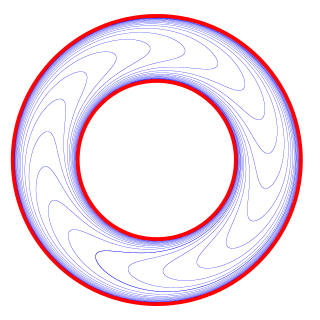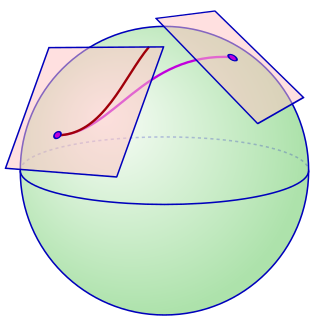
In differential geometry, the tangent bundle of a differentiable manifold is a manifold which assembles all the tangent vectors in . As a set, it is given by the disjoint union of the tangent spaces of . That is,

In mathematics, a vector bundle is a topological construction that makes precise the idea of a family of vector spaces parameterized by another space X : to every point x of the space X we associate a vector space V(x) in such a way that these vector spaces fit together to form another space of the same kind as X, which is then called a vector bundle over X.

In mathematics, and particularly topology, a fiber bundle is a space that is locally a product space, but globally may have a different topological structure. Specifically, the similarity between a space and a product space is defined using a continuous surjective map, , that in small regions of behaves just like a projection from corresponding regions of to . The map , called the projection or submersion of the bundle, is regarded as part of the structure of the bundle. The space is known as the total space of the fiber bundle, as the base space, and the fiber.
In mathematics, a principal bundle is a mathematical object that formalizes some of the essential features of the Cartesian product of a space with a group . In the same way as with the Cartesian product, a principal bundle is equipped with
- An action of on , analogous to for a product space.
- A projection onto . For a product space, this is just the projection onto the first factor, .

In mathematics, a foliation is an equivalence relation on an n-manifold, the equivalence classes being connected, injectively immersed submanifolds, all of the same dimension p, modeled on the decomposition of the real coordinate space Rn into the cosets x + Rp of the standardly embedded subspace Rp. The equivalence classes are called the leaves of the foliation. If the manifold and/or the submanifolds are required to have a piecewise-linear, differentiable, or analytic structure then one defines piecewise-linear, differentiable, or analytic foliations, respectively. In the most important case of differentiable foliation of class Cr it is usually understood that r ≥ 1. The number p is called the dimension of the foliation and q = n − p is called its codimension.
Suppose that φ : M → N is a smooth map between smooth manifolds M and N. Then there is an associated linear map from the space of 1-forms on N to the space of 1-forms on M. This linear map is known as the pullback, and is frequently denoted by φ∗. More generally, any covariant tensor field – in particular any differential form – on N may be pulled back to M using φ.

In differential geometry, an affine connection is a geometric object on a smooth manifold which connects nearby tangent spaces, so it permits tangent vector fields to be differentiated as if they were functions on the manifold with values in a fixed vector space. Connections are among the simplest methods of defining differentiation of the sections of vector bundles.
In differential geometry, a Poisson structure on a smooth manifold is a Lie bracket on the algebra of smooth functions on , subject to the Leibniz rule
In differential geometry, a G-structure on an n-manifold M, for a given structure group G, is a principal G-subbundle of the tangent frame bundle FM of M.

In differential geometry, pushforward is a linear approximation of smooth maps on tangent spaces. Suppose that φ : M → N is a smooth map between smooth manifolds; then the differential of φ, , at a point x is, in some sense, the best linear approximation of φ near x. It can be viewed as a generalization of the total derivative of ordinary calculus. Explicitly, the differential is a linear map from the tangent space of M at x to the tangent space of N at φ(x), . Hence it can be used to push tangent vectors on Mforward to tangent vectors on N. The differential of a map φ is also called, by various authors, the derivative or total derivative of φ.
In mathematics, a pullback bundle or induced bundle is the fiber bundle that is induced by a map of its base-space. Given a fiber bundle π : E → B and a continuous map f : B′ → B one can define a "pullback" of E by f as a bundle f*E over B′. The fiber of f*E over a point b′ in B′ is just the fiber of E over f(b′). Thus f*E is the disjoint union of all these fibers equipped with a suitable topology.
In differential geometry, in the category of differentiable manifolds, a fibered manifold is a surjective submersion
In mathematics, a vector-valued differential form on a manifold M is a differential form on M with values in a vector space V. More generally, it is a differential form with values in some vector bundle E over M. Ordinary differential forms can be viewed as R-valued differential forms.
In mathematics, a holomorphic vector bundle is a complex vector bundle over a complex manifold X such that the total space E is a complex manifold and the projection map π : E → X is holomorphic. Fundamental examples are the holomorphic tangent bundle of a complex manifold, and its dual, the holomorphic cotangent bundle. A holomorphic line bundle is a rank one holomorphic vector bundle.
In differential geometry, an Ehresmann connection is a version of the notion of a connection, which makes sense on any smooth fiber bundle. In particular, it does not rely on the possible vector bundle structure of the underlying fiber bundle, but nevertheless, linear connections may be viewed as a special case. Another important special case of Ehresmann connections are principal connections on principal bundles, which are required to be equivariant in the principal Lie group action.
In physics, general covariant transformations are symmetries of gravitation theory on a world manifold . They are gauge transformations whose parameter functions are vector fields on . From the physical viewpoint, general covariant transformations are treated as particular (holonomic) reference frame transformations in general relativity. In mathematics, general covariant transformations are defined as particular automorphisms of so-called natural fiber bundles.
In differential geometry, a fibered manifold is surjective submersion of smooth manifolds Y → X. Locally trivial fibered manifolds are fiber bundles. Therefore, a notion of connection on fibered manifolds provides a general framework of a connection on fiber bundles.
Let Y → X be an affine bundle modelled over a vector bundle Y → X. A connection Γ on Y → X is called the affine connection if it as a section Γ : Y → J1Y of the jet bundle J1Y → Y of Y is an affine bundle morphism over X. In particular, this is an affine connection on the tangent bundle TX of a smooth manifold X. (That is, the connection on an affine bundle is an example of an affine connection; it is not, however, a general definition of an affine connection. These are related but distinct concepts both unfortunately making use of the adjective "affine".)
Lagrangian field theory is a formalism in classical field theory. It is the field-theoretic analogue of Lagrangian mechanics. Lagrangian mechanics is used to analyze the motion of a system of discrete particles each with a finite number of degrees of freedom. Lagrangian field theory applies to continua and fields, which have an infinite number of degrees of freedom.
A Lie bialgebroid is a mathematical structure in the area of non-Riemannian differential geometry. In brief a Lie bialgebroid are two compatible Lie algebroids defined on dual vector bundles. They form the vector bundle version of a Lie bialgebra.


































